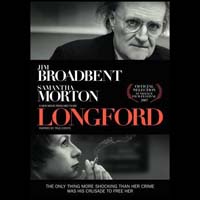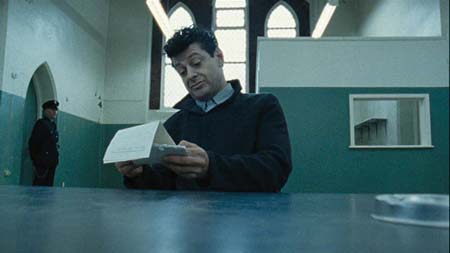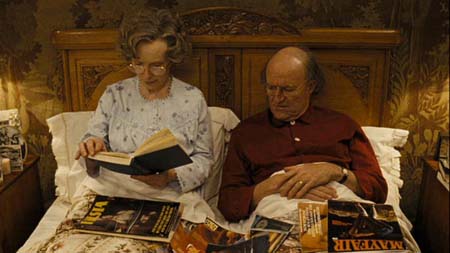
BUY IT AT AMAZON: CLICK HERE!
STUDIO: HBO Films
MSRP: $26.98
RATED: NR
RUNNING TIME: 93 Minutes
SPECIAL FEATURES:
• For the Record: Firsthand Accounts of the Moors Murders Documentary
• Commentary with director Tom Hooper and writer Peter Morgan
The Pitch
“What the fuck is a Longford? Is that some kinda porno?”
The Humans
Jim Broadbent, Samantha Morton, Lindsay Duncan, Andy Serkis
The Nutshell
In Great Britain during the 1960s, Frank Pakenham, the 7th Earl of Longford, was well-known for his campaigns in favor of prisoners’ rights. Nothing, however, could prepare him for his work with Myra Hindley, the feminine half of the infamous “Moors Murders” killers. While the rest of England saw only a horrible beast in Hindley, Pakenham saw a woman worthy of redemption.
The truth? Well, as is often par the course, lies somewhere in between.

You see that? Fucking car barrelling down on her and she just takes it. That’s fucking suave.
The Lowdown
This flick is the very definition of an actors’ piece. To be sure, the story of the Earl of Longford and his involvement with Myra Hindley is a gripping one, one that wouldn’t seem out of place in anything by John Grisham, complete with a Jagged Edge-esque twist ending. But you can sense the filmmakers’ reticence in going that route. The flick eschews the polish and style of something like A Time to Kill or The Chamber for a stripped-down, grittier look. The camerawork is grainy and handheld. There are no big courtroom scenes or dramatic speeches about justice. What we get instead are a lot of quiet, subtle conversations between Pakenham and Hindley.
And the flick works, mostly, because of how damned good Broadbent and Morton are. There’s always been a subtle fearlessness that distinguishes British actors from American ones, a willingness to play anything without fear of vanity or ego while still keeping things very grounded and real. The leads here bring that in spades. Morton’s Hindley is a far cry from the ethereal jail-bird punk a la Juliette Lewis in Natural Born Killers; she looks like a battered wife, living in perpetual fear despite the savagery of her crimes. And Pakenham, with his buck teeth and slight air of confusion, comes off as a doddering, awkward old man, rather than the cagey lead we’re used to in this type of flick.
Yet when both are on the screen, the film is riveting. The conflict here really isn’t a “did she or didn’t she” question, but rather, what do these two individuals want to gain from the other. Does Hindley truly want forgiveness and salvation, or is she using Pakenham’s status to shield her from public backlash? Likewise, does Pakenham believe in helping Myra, or is he flattered (and maybe something more) by her interest in him? We’re even given subtle clues that he may be so out-of-touch that he’s incapable of helping anyone; a funny bit shows him waging a highly derided war against pornography solely because a young child called him a “pervert” on a public bus. Broadbent and Morton always keep us thinking about the contradictions and conflicts inherent within their characters, and it’s a brave, interesting choice. Their scenes together crackle with intensity and subtext—of particular note is the final scene in the flick, a disturbing “10 years later” coda that resolves nothing, but rather forces us to re-examine each of these two people in a vastly different light.

"So, you remember the day you dried up too, huh?"
Now, while Broadbent and Morton are terrific, the movie itself is only good. I applaud director Tom Hooper’s choice to deglamorize everything, but I think he’s not quite that talented a director to make it work as well; some of the shot compositions are jarring and borderline amateurish to look at, undermining the work being done by the actors. His wide-lens introduction to Longford’s office and Myra’s trip through the Moors are the two most egregious examples. And though writer Peter Morgan (coming off a banner-year with his work on both The Queen and The Last King of Scotland) does a commendable job of condensing 30-odd years of events into only 93 minutes, I felt his script could have adhered to the “show, don’t tell” axiom a little more. We see next to nothing of Myra’s prison conditions or her supposed crimes themselves, but we hear lots instead, and I think a little more visual information could have raised the stakes dramatically even more.
Still, Hooper and Morgan’s work can be forgiven. What can’t is the over-the-top and hammy work on display from Andy Serkis. I love the man—for his work in the Lord of the Rings and The Prestige he’s earned almost enough geek points to last a lifetime. But here, as Hindley’s far more aggressive cohort in murder, Serkis is at tonal odds with the rest of the film. I get the feeling he’s supposed to be jarring in order to stand out more in this otherwise somber flick, but when ranked in the annals of vicious serial killer portrayals, his work is Anthony Hopkins in Red Dragon-bad.

"Okay Pete, here’s what I’m thinking looking at the new script. I could go Eddie Murphy and play the dead girl’s whole family. No? How about you CGI me as Susie herself? I can see it now: ‘Andy Serkis is The Lovely Bones.’"
On the whole, these are small potatoes in an otherwise solid flick. It’s a legal slice of history somewhat alien to American culture, and I found it (mostly) fascinating.
The Package
The image here is gritty, but that’s to be expected; the mix of handheld cameras and aging archival footage is never going to look like Sin City. I thought the sound was a bit weak, if only because it was on a basic Dolby 2.0 track. As for the box, it’s very apropos, given the nature of the flick—serious black and white shots of Morton and Broadbent.
I enjoyed the commentary a great deal. Morgan and Hooper talk about the challenges of blending their footage with the old newsreel stuff, which, as a Zelig-fan, I always find neat, and they gave more background details on the Moors Murders. This was the main detail the flick lacked (understandably so, as the British probably know all the pertinent details already), so it put a lot of the on-screen stuff in context for me. Actually, it did a better job than the documentary on the disc, which at just over six minutes, seemed more like the Cliff Notes version of the real thing.
This is not a perfect film or DVD; there are some noticeable direction, writing, and performance issues, and the sound and features hear leave something to be desired. But Broadbent and Morton are just about perfect, and that goes a long way. Just long enough, I’d say.

You know, I used to think Elderly Porn was pretty gross, but I gotta tell ‘ya: I’m finding this here extremely arousing.